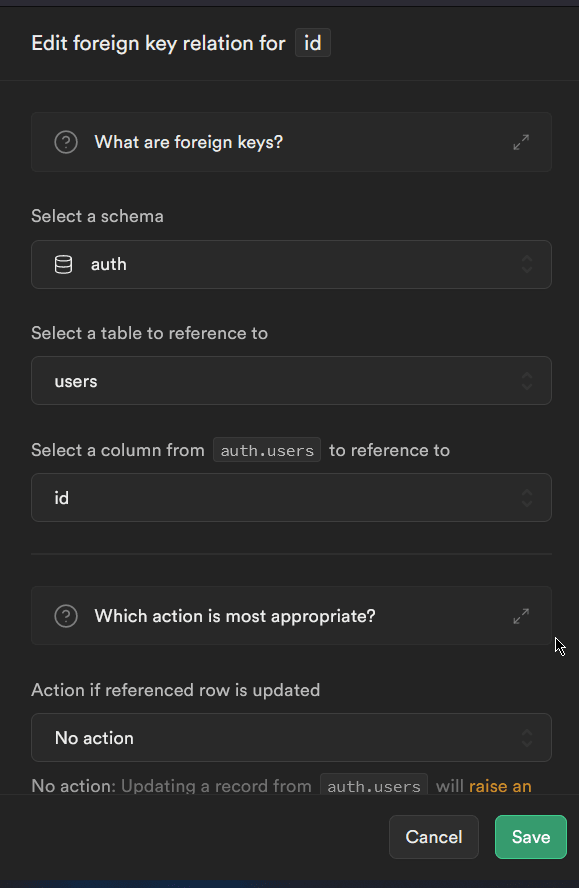This article follows my Row Level Security one …
As I was doing my tests I came across an issue whereby the user_data table wasn’t created if there was issue with connectivity. The upsert that I was trying to run wouldn’t fire.
That got me thinking; the profiles table gets created when a user signs up, right? Something, somewhere is being automated to accomplish that. But how?
So, I went on another adventure…
I went searching in my project to see what had been done when I was following the guide that I was using as a starting point. What I discovered was really interesting. The starter that I used from the guide – User Management – created a function. What that function does is create a profiles table row and populates it with certain fields.
That looks like this:
begin
insert into public.profiles (id, full_name, avatar_url)
values (new.id, new.raw_user_meta_data->>'full_name', new.raw_user_meta_data->>'avatar_url');
return new;
end;
With this knowledge, I went digging further and found out that functions are the first key to the puzzle I was trying to solve, the other being triggers.
What Are Triggers?
Triggers allow us to watch database events (insert, update, delete) and call a function whenever they occur, allowing us to automate functionality in our database while keeping our data in sync.
Automating Database Events
The automation that I need is comprised of three main aspects:
- Relations
- Functions
- Triggers
Relations
Recall in the last article I said I wasn’t going to delve into table relations. For the coming steps, relations are the lynch pin to a lot of what I want to accomplish.
Profiles Table
To start off, here’s the relation between my profiles table and the auth.users one:
The
auth.userstable is from the authentication service I talked about in the prior article.
User Data Table
I could choose to link this table directly to the auth.users one, the same way the profiles one is – but that creates a separate relation. What I want is to relate the user_data one to the profiles one. In essence; an authenticated user has related profile data as well as user data.
So instead I have made the relation to the profiles one – that way everything is connected.
Functions
Triggers, from what I learnt, require functions. Naturally, I started there. The requirements for my function were straightforward:
- when a row in the
profilestable is created, create a row in theuser_datatable that is related byid
The settings for functions and triggers can be found in the Database area of my project.
Creating The Function
Let’s go through the steps to create a function and the important aspects to take note of.
- Return Type: Because we are making a function that a trigger will call, we have to set its return type to trigger
- Definition: This is the core of what our function will be doing. It will be similar to the one before:
begin
insert into public.user_data(id)
values (new.id);
return new;
end
- Type of Security: It is necessary to change this to SECURITY DEFINER. This is to ensure that the trigger is run with the same privileges as a dashboard user. If left as SECURITY INVOKER, it would fail because the user trying to run does not have the necessary permissions.
Triggers
With the function ready, let’s create the trigger that calls it.
Creating The Trigger
These are the important aspects to take note of when creating a trigger.
- Table: We have to set the table that is to be watched for changes. In our case, as we discussed, it’s the profiles table.
- Events: Here we specify what kind of action will invoke our trigger. We want INSERT events.
-
Trigger Type: Next is to set when we want the trigger to run. We need it to run after because we require there to be a row in the profiles table to be created first. That way it is correctly related.
-
Orientation: As we want accompanying data for each user that is created, we set this to Row. Otherwise, it would only run once and fail on subsequent attempts.
-
Function to trigger: Lastly, we choose the function we need to be triggered.
Recapping
With all that set up we have a trigger. What it does is create a row in the user_data table whenever and insert event happens in the profiles table. All this is linked via the id.
Conclusion
As with most things in Supabase, this also wasn’t that hard to get up and running. The beauty also is that I know exactly what is going on and what I have to do if I need to modify or add to it.
This adventure has been very fruitful. The fact that I can ensure that I can ensure that user data and info is created and related fills me with confidence.
Thank you for reading, let’s connect!
Thank you for visiting this little corner of mine. Let’s connect on Twitter, Discord and LinkedIn








